|
|
Oops!! I had an entry written for Tuesday, just waiting for the obligatory photograph, but somehow my title was published and nothing else was saved. So here is the delayed version of Tuesday’s events, maybe the extra hindsight will shed a different light on our activities…
We started off the morning with an hour of rechecks (Stuart and Gretel have limited the amount of time we are allowed to spend on them to limit the frustrating and demoralizing experience of looking for plant after plant and rarely finding any trace). It’s not all bad though, because among the strings of can’t finds, there is, on rare occasion, a tiny, fuzzy, triple lined leaf of echinacea peaking through the grasses (or sometimes a large and blatantly obvious one), and finding one of those is always worth a shout of joy.
Later, Maria, Gretel and I returned to the common garden to remeasure a few other plants whose measurements didn’t quite seem normal. We searched in vain for a black head someone recorded a no twist tie as being on the same head as, removed a few staples where there had been no records of staples ever being placed, and remeasured a head whose height had been recorded as 95cm (normal for pallida maybe, but not angustifolia).
In the afternoon Katherine, Jill, and Stuart took the GPS out to finish demography at On 27.
The rest of the day we spent working on independent projects. We’ve found out that our posters need to be finished by 10am next Monday so I think we all appreciated a little extra time. I spent most of my time on R again, it would probably take me less time if Stuart just told me exactly what to do, but figuring out what I can on my own is more rewarding, and this way I actually understand what I’m doing and will be able to figure out R again next time I need it. Kelly and I did spend about two or three hours trying to figure out how to show the number of flowers that had started flowering by each day, and after a few premature high fives, and one or two nudges in the right direction from Stuart we eventually produced a beautiful graph. At least it will be once Kelly changes the axis labels from accumprop and sDints and makes it so those of us who don’t know what those mean can make sense of what it means.
Working out in the common garden recently the views have been changing. Goldenrod is in full bloom along the edges and Big Blue Stem and Indian Grass have sent up tall stems (culms) and begun flowering. Some of the culms reach up above my head and I makes me wonder what it would have been like to walk through a prairie full of them.
Indian Grass- Sorghastrum nutans



So what do 696 ants look like?
 Like this. Like this.
I believe these guys are Formica obscuripes. The Formica genus can be identified by the three very distinct ocelli on their foreheads and the short but prominent frontal carinae, the two dark lines extending upward from the bases of the antennae.
 For most of Friday I worked through my pitfall traps, with Katherine diligently sorting through hundreds of ants, grouping them by the most similar-looking. For most of Friday I worked through my pitfall traps, with Katherine diligently sorting through hundreds of ants, grouping them by the most similar-looking.
 We also encountered a few questionable ants which may also be Formica obscuripes, but with highly inflated gasters. We also encountered a few questionable ants which may also be Formica obscuripes, but with highly inflated gasters.

The progress is slow, but steady– by 5pm, we finished 12 of the 144 traps.
Aside from my life in antworld, the other members of Team Echinacea worked on their individual projects and completed a few smaller tasks including:
-GPSing the recruitment plots
-GPSing a few positions in the common garden
-Scanning data sheets for Amy
-Entering data from seedling searches
Overall, Friday was very productive for all of us and we look forward to more days like it this coming week.
Now that Team Echinacea has (finally!) finished measuring plants in CG1, we’ve started a couple of new activities. In the morning a group went into CG1 to place staples at locations where plants have not been found for the past three seasons. These staples help us to keep track of distance between plants when measuring.
In the afternoon, almost everyone went out to the North of Railroad and Railroad sites to work on demography. In brief, demography is a way to keep track of plants in the prairie remnants that Team Echinacea studies by finding and taking the GPS locations of flowering plants every year. By understanding how often plants flower and how often new plants flower for the first time, we can get a better idea of whether or not a population is stable.
As a Flog Post bonus, I’m including some haikus that I wrote yesterday morning when we were trapped indoors by the rain. I’ve written one about each Team Echinacea member’s project this year as well as several more general haikus about what we do. Enjoy!
The Echinacea Project Haikus.doc
As dawn broke on yet another day in Kensingtonville, Team Echinacea arose to a dark sky producing ominous rumbles of thunder. An occasional pitter-patter turned into a steady fall of condensed water vapor. The team members wearily turned to each other and half-heartedly debated whether to arrive at base per normal routine. Some, namely Katherine, Jill, and Greg, decided that it would be best to separate from the rest of the crew for a while and work under the grey skies above. Those who remained in the heart of Kensingtonville hurriedly tried to edit abstracts whilst waiting for the skies to be more favorable. After a few dreary hours, sunrays started to peek through the clouds, and then suddenly burst out with blinding brilliance, stunning those indoors. After the initial shock of seeing sunshine, select members of the crew finished their abstracts and drifted off into the land of unicorns and chocolate chip cookies.
After lunch, the two parts of the crew decided that it would be in our best interest to come back together and work as a brave platoon to conquer the plot that is Caroline’s, over yonder at Hegg Lake. After a few encounters with fierce toothpicks and cardinal directions, Team Echinacea prevailed!! (And finished early. Woohoo!!)

Team Echinacea has taken on another difficult task: the task of mastering the Dread Pirate R. And his crew of R.O.U.S.’s (R-scripts Of Unusual Size). R comes to you at night and steals your sanity. But only part of it. There’s a big difference. The crew has differing opinions about R:
Those who don’t mind it too much:

And those who mind it quite a bit:

On the brighter side of the spectrum, the crew finished the day early, and therefore had more time to lounge around/nap/work on projects. A few decided to go for a swim in the great Elk Lake before dinner (which was quite nice, if I might say so myself).
Tuesday morning marked the end of measuring in the common garden!!!! It was slightly anticlimactic with only one and a half rows left to finish but it is still rewarding to be finished.
It was a rainy morning so we didn’t get out to the common garden until about 10:30, but we had time to pull all of the thistles between measuring and lunch. Now there will be one less prickly plant to avoid when we return to recheck missing plants and contradictory records in the next few weeks.
While the rest of us were working inside or in the common garden Katherine and Jill spent a long morning at work in the remnants performing their aphid and any survey. They made significant progress, leaving only two small sites to finish on wednesday, and found Kelly’s sunglasses that she had lost at Staffanson.
We had been planning to spend the afternoon measuring in the common garden, but since we finished earlier than expected we had the rest of the day to work on individual projects. Many of us took the opportunity to prepare abstracts for submission to the University of Minnesota for the poster session we will be presenting at on August 9th. It turns out that abstracts become more challenging to write when you are still floundering through R endeavoring to analyse your results, but as Stuart reminded us, all (or most) of the other presenters are likely to be facing the same challenges.
I haven’t been very good about taking photos recently, but while I’m on the topic of individual projects here are two photos that relate to my work. The first one is E. angustifolia and the second is E. pallida. You can see how they have a slightly different appearance.


This week started off strong with a morning of dedicated work on independent projects; Jill and Katherine visited a couple of remnants to work on the ant and aphid surveys, Maria continued her observations at Hegg lake, and the rest of us enjoyed the cool of the Hjelm house as we put or noses to the grindstone, analyzing our data and beginning to work on our posters. To help us prepare for writing our abstracts, before lunch Stuart gave a quick tutorial on putting hypotheses into words, a task that some of us found surprisingly challenging. After lunch Jennifer Ison gave a presentation which she had prepared for the recent evolution meeting, and we finished off the day by measuring the last major set of rows in the big batch garden. Now only 1 and 1/2 rows left.. Woohoo!
 Jill is busy looking for those ants and aphids. Jill is busy looking for those ants and aphids.
Sunday was a much-anticipated day off for all of us in K-town. Kelly’s grandparents were in town, Lydia was off working at Mount Carmel, and Andrew spent time with his girlfriend, Kelsey, showing her around the research sites. Meanwhile, I slept in and made “bark stuff” (an addicting chocolaty dessert) to satisfy my weeklong chocolate craving. I also GRE-ed, made a concerted effort to learn more Italian verbs, and worked on some things for my research back in Maine. Although I don’t have any pictures from the day, I do have some pictures of my research sites in Maine for those who haven’t seen a heaping hunk of serpentine before. The top picture is Pine Hill, a serpentine outcrop, and the picture below it is Settlement Quarry, a granite outcrop.
 
Friday morning started out with a quick round of phenology in the common garden. Split between four or five of us it only took about 20 minutes each and it seems like flowering is just about done! From what every one who has been here in previous years, this year appears to be earlier than usual.
After phenology we all had a few hours to work on our individual projects. Although a few people are still doing fieldwork, most of us are done or beginning to wrap up, and moving on to data analysis. I transferred my first data set to R and started attempting to figure out how to organize it with some help from Stuart.
We had an early lunch to allow for a longer stretch of work in the afternoon and managed to finish measuring at Jennifer’s plot at Hegg Lake a few minutes after 5pm. We took a short and very welcome break halfway through for watermelon that Jennifer brought. And managed not to loose any surveying pins, despite me forgetting to pick up the pile I made and Maria’s attempts to hide one in her flag bag.
Here is a link to a csv of my data sheet!
angustifoliacrossdata_2012_all_locations.csv
And also, here’s the script that I used in R.
Compatibility script.r.txt
Imagine walking into a foggy wonderland where all you can hear is the sound of birds, frogs, and the occasional drip of water. Well, you should be jealous because that’s where we spent our morning: Hegg Lake!

We spent the entire morning measuring Jennifer’s plot, and we are nearly halfway done (I think). Take that, echinacea!

This afternoon after lunch, Jennifer gave us her presentation on her work with assortative mating based on phenology. Stuart then briefed us on doing demography in the remnants, where we find all of this year’s flowering plants and record data on them and then GPS their coordinates.

And now most of us are sitting around as we eagerly await an all-Amerrrrrican dinner of mashed potatoes, corn-on-the-cob, veggies, and apple crisp lovingly prepared by Kelly and Andrew! Nom nom nom….
|
|


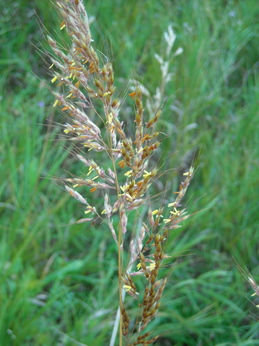
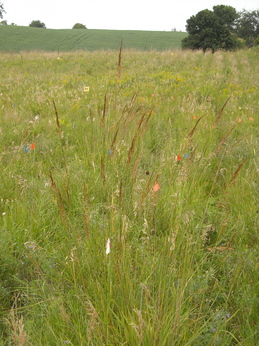

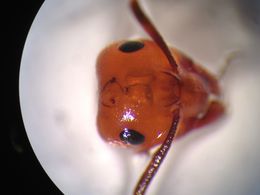
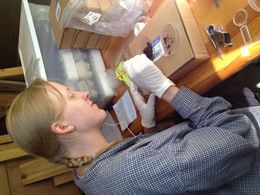

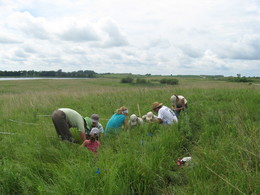
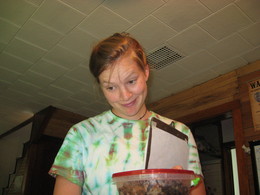

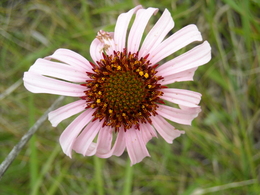



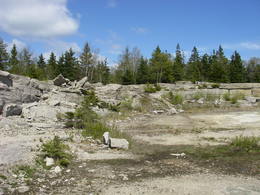
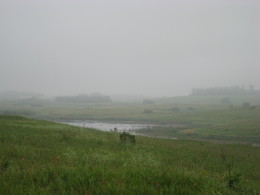
-thumb-260x195-128753.jpg)
